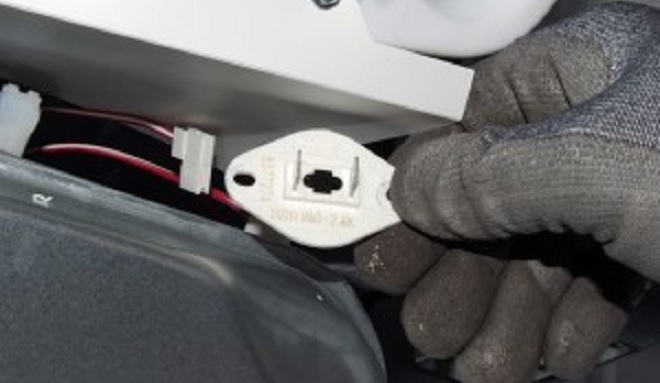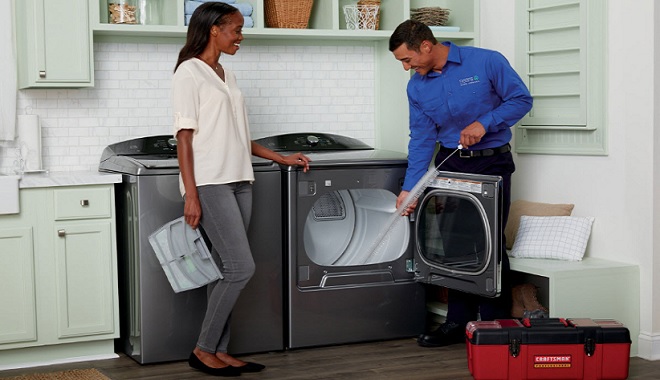Schedule your dryer repair now!
How to Replace a Faulty Dryer Thermostat
The thermostat in your dryer regulates heating temperature so clothes get dry without overheating. A failed operating thermostat can prevent the dryer from heating or cause the dryer to overheat and damage garments.
KEY TAKEAWAYS
- Before replacing a dryer thermostat, test for continuity with a multimeter; if there's none, replace the thermostat.
- Electronic dryers use a thermistor instead of a thermostat, which senses temperature changes and regulates heat.
- For complex dryer issues or if technical information is unavailable, seeking professional help from service technicians, like those from Sears Home Services, can ensure proper diagnosis and repair.
When you notice one of these symptoms, you may need to replace the operating thermostat in your dryer.
The thermostat is typically located on the blower housing. Follow these steps to replace a faulty dryer thermostat.
- Unplug the dryer to disconnect electrical power. Shut off the gas supply if you have a gas dryer.
- Remove the back panel to access the thermostat on the blower housing.
- Pull the wires off the thermostat terminals.
- Remove the mounting screws and pull the thermostat off the blower housing.
- Position the new thermostat on the blower housing and install its mounting screws.
- Connect the wires to the thermostat terminals.
- Reinstall the dryer back panel.
- Plug the dryer back in to restore electrical power. Open the gas supply valve if you have a gas dryer.
Replacing a faulty dryer operating thermostat will fix a dryer heating problem.
If your dryer fails to heat after replacing the operating thermostat, then an additional failure is likely plaguing your dryer. View this DIY troubleshooting video to find the cause of an electric dryer heating problem:
View this DIY troubleshooting video to fix a gas dryer that won’t heat after replacing the operating thermostat: Gas Dryer Won’t Heat Troubleshooting Video.
Read on for more information about dryer thermostats.
How to know if the Dryer Thermostat is Bad
Before replacing the dryer thermostat, test for continuity using a multimeter.
- Unplug the dryer before accessing the thermostat. Shut off the gas supply if you have a gas dryer.
- Access the thermostat. The operating thermostat is typically located on the blower housing. On many common dryers, you’ll need to remove the back panel to find the thermostat.
- Remove at least one wire from the thermostat terminals.
- Using a multimeter, measure continuity through the thermostat terminals.
If the meter measures no continuity, you’ll need to replace thermostat.
If the dryer overheats, the operating thermostat can also be faulty but it’s difficult to test the themostat to see if it trips when its temperature reaches the trip rating (typically 155 degrees F – see the rating on the thermostat).
If the dryer overheated and tripped the high-limit thermostat or thermal cut-off fuse, you’ll typically need to replace the operating thermostat because it failed to cycle off when it reached its trip temperature. The high-limit thermostat and thermal cut-off fuse protect the dryer from overheating when the operating thermostat fails to shut off the heat properly.
When you’re unsure whether the operating thermostat in your dryer is faulty, it’s best to have the dryer examined and repaired by a service technician.

What if My Dryer Doesn’t Have a Thermostat?
Dryers with electronic control boards use a thermistor (temperature sensor) instead of a thermostat to regulate heat inside the dryer. The thermistor senses temperature and the control board cycles the heating system based on the temperature reading.
How Does a Thermistor Work?
The thermistor is a sensor whose electrical resistance changes with temperature. As temperature rises, the thermistor’s resistance decreases. As it cools down, the thermistor’s resistance increases.
The electronic control board in the dryer sends a low voltage signal through the thermistor to detect resistance. Higher resistance through the thermistor allows less voltage to return to the control board through the temperature sensing circuit. The control board determines temperature based on voltage that makes it through the thermistor circuit.
How to Test a Thermistor
DIY’ers can test a thermistor by unplugging the dryer, accessing the thermistor and checking its resistance at room temperature and capering that resistance value to the expected reading. For many dryer thermistors, you should measure around 11,000 ohms (11K ohms) at room temperature.
If thermistor resistance is off by more than 2,000 ohms, you’ll typically need to replace the thermistor.
Not all thermistors measure 11K ohms of resistance at room temperature. Before testing and replacing a thermistor, you’ll need to find the technical information for the thermistor in your model of dryer. That information is often provided on a tech sheet that you’ll find in the control console or through an online search for the information.
If you’re unable to find the technical information for your dryer or you prefer to have a professional service provider check the thermistor, schedule service and we’ll have a Sears Home Services Technician visit your home and examine your dryer. Our service technicians average 10+ years of experience and we can repair practically any brand of dryer – no matter where you bought it.

How to Keep the Dryer Heating Correctly
Whether your dryer has a thermostat or thermistor, annual professional maintenance will help keep it heating and operating properly. During maintenance, our Sears Home Services Technician will measure dryer operating temperature to check the operation of the thermostat or thermistor.
Additionally, the technician will check these dryer issues:
- Check the exhaust system. Lint and debris clogs in the exhaust vent system cause the dryer to take longer to dry clothes. Clothes tumbling in the dryer also can overheat when the exhaust vent system is clogged. The technician will check for leaks, kinks and obstructions.
- Vacuum inside and around the dryer. The technician will vacuum inside the exhaust vent to remove lint and debris that can cause the dryer to overheat and take longer to dry clothes. Lint buildup inside the dryer even can lead to a fire if not cleaned regularly.
- Inspect the heating system. The technician will check the heating element in an electric dryer or the burner assembly in a gas dryer. The dryer won’t heat efficiently if the burner or element has problems. The technician will check the gas line and connections for leaks, which could lead to a fire.
- Check the drum, drive system and drum seals. The dryer won’t heat and dry properly if drum seals are worn or damaged. Problems with the drum, drum support rollers, drum belt and drive motor can prevent the drum from rotating to tumble and dry the clothes properly.
- Examine the moisture sensor. The moisture sensor detects dampness in tumbling clothes inside the dryer. If the moisture sensor is coated with deposits (often caused by dryer sheets), the sensor won’t detect moisture and the dryer will stop while clothes are still damp. The technician will clean the sensor if it’s dirty.
- Inspect the power cord and electrical connections. Damage to the power cord or wiring in the dryer can trip the house circuit breaker for the dryer. A wiring short also can damage internal dryer components such as the electronic control board.
- Check controls. Whether your dryer has a timer or an electronic control board, the technician will check control operation. The dryer won’t dry your clothes properly if the control doesn’t work properly.
Keeping your clothes dryer in top shape with regular professional maintenance will prevent unexpected breakdowns and help your dryer last longer. Schedule your dryer maintenance check and cleaning today.

Sears Home Services can help you keep all of your appliances in top shape. Schedule a Kitchen & Laundry Appliance Clean & Maintain Bundle and we’ll send a technician to service all of your home appliances in one convenient visit.
Helping you manage your home smoothly is job # 1 at Sears Home Services. You can count on us for the support you need for home maintenance, repair and improvement.
Schedule your dryer repair now!
Count on our knowledgeable technicians to provide thorough dryer repairs, ensuring your appliance operates at peak performance for years to come.
Was this information helpful?
Repair Dryer Resources
Uneven loads can cause a dryer not to heat properly. Make sure to wash and dry similar items together for proper performance.
Discover the top 10 reasons why your dryer won't heat with Sears Home Services.
Unlock the secrets to resolving your most frustrating dryer dilemmas with expert insights and tips.
Discover why your dryer isn't drying clothes in 2024. Get expert advice from Sears Home Services today!
